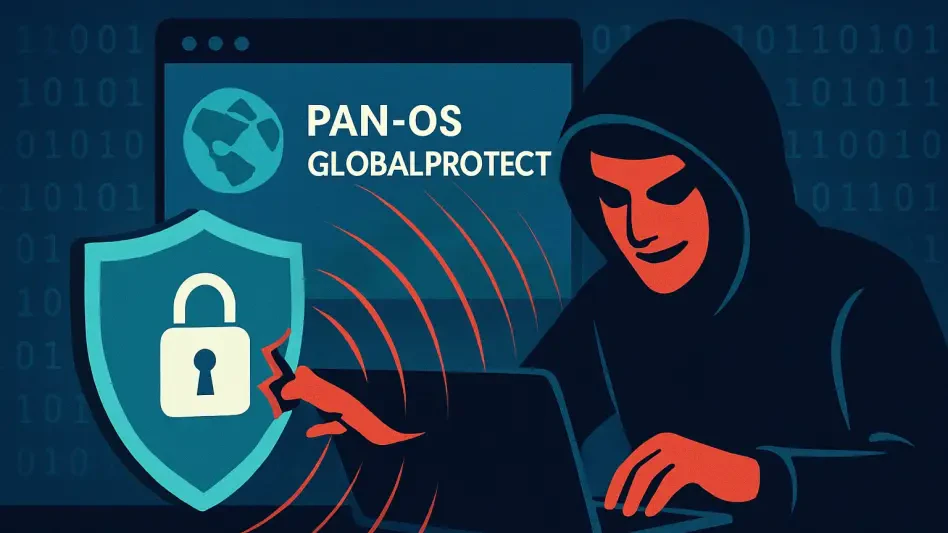In an alarming development for cybersecurity professionals, a widespread scanning campaign has emerged across the internet, targeting a critical vulnerability in Palo Alto Networks’ GlobalProtect portal. Identified as CVE-2024-3400, this flaw in the PAN-OS software allows for arbitrary file creation, potentially leading to devastating OS command injection attacks. Security researchers have detected systematic probing from a single IP address, highlighting how easily attackers can automate their efforts to locate and exploit unpatched systems. The urgency to address this issue cannot be overstated, as the vulnerability carries a perfect CVSS 4.0 score of 10.0, signaling its severe impact potential. With public exploit code already circulating, organizations relying on affected PAN-OS versions face heightened risks of compromise. This situation underscores the critical need for immediate action to protect vital network infrastructure from opportunistic threat actors and automated botnets seeking to gain root-level control.
1. Rising Threat of Automated Scanning Campaigns
The discovery of a coordinated scanning effort targeting the GlobalProtect portal has raised significant concerns within the cybersecurity community. Researchers at SANS ISC have identified a specific IP address issuing crafted POST and GET requests against the GlobalProtect file-upload endpoint. These requests manipulate session IDs to create unauthorized files in the system directory, a clear indication of malicious intent. This automated approach demonstrates how attackers can efficiently scan vast numbers of internet-facing devices to pinpoint vulnerable firewalls. The ease of such automation amplifies the threat, as it allows adversaries to cover extensive ground in minimal time. Organizations with exposed systems are particularly at risk, as these scans are often precursors to more aggressive exploitation attempts. The simplicity of the two-step process—file creation followed by confirmation—further illustrates why this vulnerability is so attractive to threat actors looking for quick wins in their campaigns.
Beyond the initial scans, the potential for escalation looms large if vulnerabilities remain unaddressed. Once attackers confirm the presence of a created file through a “403 Forbidden” response, they can chain this flaw with other techniques to execute operating system commands. This could grant them root-level access to the affected firewall, compromising the entire network’s security. While no widespread breaches have been confirmed in the wild beyond proof-of-concept exploits, the network-accessible nature of this flaw makes it a prime target. The absence of authentication requirements further lowers the barrier for entry, inviting both skilled hackers and automated botnets to exploit the issue. As scanning activity continues to surge, organizations must recognize that these early probes are likely just the beginning. The risk of full-system compromise grows with each passing day that systems remain unpatched, emphasizing the need for vigilance and proactive defense measures.
2. Understanding the Critical Vulnerability Details
Delving into the specifics of CVE-2024-3400 reveals why this flaw poses such a significant threat to organizations using PAN-OS software. This vulnerability, which enables arbitrary file creation, affects specific versions of PAN-OS ranging from 10.2 to 11.1, with detailed version ranges provided by Palo Alto Networks. Rated with a CVSS 4.0 score of 10.0 and labeled as “HIGHEST” urgency, the flaw can lead to OS command injection, a severe outcome for any network security device. Importantly, only systems configured with a GlobalProtect portal or gateway are impacted, while Cloud NGFW, Panorama, and Prisma Access remain unaffected. The critical nature of this issue is compounded by the availability of public proof-of-concept exploits, which provide attackers with ready-made tools to test and deploy against unpatched environments. Such exposure significantly heightens the risk for organizations that have yet to apply necessary updates.
The implications of this vulnerability extend far beyond theoretical risks, as its exploitation could disrupt core network security infrastructure. Attackers gaining root-level control over a firewall could manipulate traffic, steal sensitive data, or even use the compromised system as a foothold for broader attacks. The lack of confirmed widespread exploitation at this stage offers a narrow window of opportunity for organizations to act before threat actors capitalize on the flaw. Security teams must prioritize understanding the affected versions and configurations within their environments to assess their exposure accurately. Palo Alto Networks has provided clear guidance on impacted systems, making it imperative for administrators to review their setups against the listed ranges. As persistence techniques associated with this vulnerability also surface online, the potential for long-term compromise grows, urging immediate attention to patching and mitigation strategies to safeguard critical assets.
3. Actionable Steps to Mitigate Risks
In response to the escalating scanning activity targeting CVE-2024-3400, organizations must adopt a multi-layered approach to secure their systems. The first and most critical step is to apply the latest updates to PAN-OS, specifically to versions 10.2.9-#, 11.0.4-#, and 11.1.2-###, as recommended by Palo Alto Networks. Hotfixes for other maintenance releases are also available to ensure broader coverage. Beyond patching, organizations with a Threat Prevention subscription should enable specific signatures—95187, 95189, and 95191—to block exploit attempts at the GlobalProtect interface. These measures provide an essential line of defense against automated scans and targeted attacks. Additionally, monitoring for anomalous requests, such as unusual POST or GET activity to specific endpoints like hipreport.esp, can help detect early signs of probing. Alerting on atypical user-agent strings or repeated error responses further strengthens an organization’s ability to respond swiftly.
For environments where compromise may have already occurred, enhanced recovery procedures are necessary to ensure full remediation. Following Palo Alto Networks’ guidance on factory-reset processes, accessible through their customer support, is vital for restoring affected devices to a secure state. Continuous monitoring remains a cornerstone of defense, as scanning surges and public exploit code increase the likelihood of attempted breaches. Security teams should also maintain a proactive stance by regularly reviewing logs for suspicious patterns that could indicate exploitation attempts. Deploying threat prevention signatures alongside timely updates creates a robust barrier against potential full-system compromise. As the landscape of cyber threats evolves, staying ahead of adversaries requires not only immediate action but also a commitment to ongoing vigilance. By implementing these strategies, organizations can significantly reduce their exposure to this critical vulnerability and protect their network infrastructure from severe consequences.








